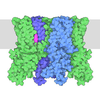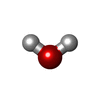+ Open data
Open data
- Basic information
Basic information
| Entry | Database: PDB / ID: 9h77 | ||||||
|---|---|---|---|---|---|---|---|
| Title | MPP8 chromodomain in complex with nanobody 3A02 | ||||||
 Components Components |
| ||||||
 Keywords Keywords | GENE REGULATION / chromodomain / chromatin-binding / nanobody | ||||||
| Function / homology |  Function and homology information Function and homology informationconstitutive heterochromatin formation / transposable element silencing by heterochromatin formation / histone H3K9me2/3 reader activity / negative regulation of gene expression via chromosomal CpG island methylation / negative regulation of gene expression, epigenetic / : / heterochromatin / Regulation of endogenous retroelements by the Human Silencing Hub (HUSH) complex / nucleosome / chromatin binding ...constitutive heterochromatin formation / transposable element silencing by heterochromatin formation / histone H3K9me2/3 reader activity / negative regulation of gene expression via chromosomal CpG island methylation / negative regulation of gene expression, epigenetic / : / heterochromatin / Regulation of endogenous retroelements by the Human Silencing Hub (HUSH) complex / nucleosome / chromatin binding / nucleolus / nucleoplasm / nucleus / plasma membrane / cytoplasm / cytosol Similarity search - Function | ||||||
| Biological species |   Homo sapiens (human) Homo sapiens (human) | ||||||
| Method |  X-RAY DIFFRACTION / X-RAY DIFFRACTION /  SYNCHROTRON / SYNCHROTRON /  MOLECULAR REPLACEMENT / Resolution: 2.01 Å MOLECULAR REPLACEMENT / Resolution: 2.01 Å | ||||||
 Authors Authors | Richards, M.W. / Bayliss, R. | ||||||
| Funding support |  United Kingdom, 1items United Kingdom, 1items
| ||||||
 Citation Citation |  Journal: To Be Published Journal: To Be PublishedTitle: Gluebodies improve crystal reliability and diversity through transferable nanobody mutations that introduce constitutive close contacts Authors: Ye, M. / von Delft, F. #1: Journal: Acta Crystallogr D Struct Biol / Year: 2019 Title: Macromolecular structure determination using X-rays, neutrons and electrons: recent developments in Phenix. Authors: Dorothee Liebschner / Pavel V Afonine / Matthew L Baker / Gábor Bunkóczi / Vincent B Chen / Tristan I Croll / Bradley Hintze / Li Wei Hung / Swati Jain / Airlie J McCoy / Nigel W Moriarty ...Authors: Dorothee Liebschner / Pavel V Afonine / Matthew L Baker / Gábor Bunkóczi / Vincent B Chen / Tristan I Croll / Bradley Hintze / Li Wei Hung / Swati Jain / Airlie J McCoy / Nigel W Moriarty / Robert D Oeffner / Billy K Poon / Michael G Prisant / Randy J Read / Jane S Richardson / David C Richardson / Massimo D Sammito / Oleg V Sobolev / Duncan H Stockwell / Thomas C Terwilliger / Alexandre G Urzhumtsev / Lizbeth L Videau / Christopher J Williams / Paul D Adams /    Abstract: Diffraction (X-ray, neutron and electron) and electron cryo-microscopy are powerful methods to determine three-dimensional macromolecular structures, which are required to understand biological ...Diffraction (X-ray, neutron and electron) and electron cryo-microscopy are powerful methods to determine three-dimensional macromolecular structures, which are required to understand biological processes and to develop new therapeutics against diseases. The overall structure-solution workflow is similar for these techniques, but nuances exist because the properties of the reduced experimental data are different. Software tools for structure determination should therefore be tailored for each method. Phenix is a comprehensive software package for macromolecular structure determination that handles data from any of these techniques. Tasks performed with Phenix include data-quality assessment, map improvement, model building, the validation/rebuilding/refinement cycle and deposition. Each tool caters to the type of experimental data. The design of Phenix emphasizes the automation of procedures, where possible, to minimize repetitive and time-consuming manual tasks, while default parameters are chosen to encourage best practice. A graphical user interface provides access to many command-line features of Phenix and streamlines the transition between programs, project tracking and re-running of previous tasks. | ||||||
| History |
|
- Structure visualization
Structure visualization
| Structure viewer | Molecule:  Molmil Molmil Jmol/JSmol Jmol/JSmol |
|---|
- Downloads & links
Downloads & links
- Download
Download
| PDBx/mmCIF format |  9h77.cif.gz 9h77.cif.gz | 101.4 KB | Display |  PDBx/mmCIF format PDBx/mmCIF format |
|---|---|---|---|---|
| PDB format |  pdb9h77.ent.gz pdb9h77.ent.gz | 61.7 KB | Display |  PDB format PDB format |
| PDBx/mmJSON format |  9h77.json.gz 9h77.json.gz | Tree view |  PDBx/mmJSON format PDBx/mmJSON format | |
| Others |  Other downloads Other downloads |
-Validation report
| Summary document |  9h77_validation.pdf.gz 9h77_validation.pdf.gz | 436.3 KB | Display |  wwPDB validaton report wwPDB validaton report |
|---|---|---|---|---|
| Full document |  9h77_full_validation.pdf.gz 9h77_full_validation.pdf.gz | 437.8 KB | Display | |
| Data in XML |  9h77_validation.xml.gz 9h77_validation.xml.gz | 17.6 KB | Display | |
| Data in CIF |  9h77_validation.cif.gz 9h77_validation.cif.gz | 23.6 KB | Display | |
| Arichive directory |  https://data.pdbj.org/pub/pdb/validation_reports/h7/9h77 https://data.pdbj.org/pub/pdb/validation_reports/h7/9h77 ftp://data.pdbj.org/pub/pdb/validation_reports/h7/9h77 ftp://data.pdbj.org/pub/pdb/validation_reports/h7/9h77 | HTTPS FTP |
-Related structure data
| Similar structure data | Similarity search - Function & homology  F&H Search F&H Search |
|---|
- Links
Links
- Assembly
Assembly
| Deposited unit | 
| ||||||||||||
|---|---|---|---|---|---|---|---|---|---|---|---|---|---|
| 1 | 
| ||||||||||||
| 2 | 
| ||||||||||||
| Unit cell |
|
- Components
Components
| #1: Antibody | Mass: 13241.887 Da / Num. of mol.: 2 / Mutation: S8N, Q14K, T117M Source method: isolated from a genetically manipulated source Details: This is a camelid nanobody that binds to the chromodomain of MPP8. The construct incorporates 'gluebody' mutations in the nanobody scaffold that promote crystallisation by generating crystal contacts. Source: (gene. exp.)   #2: Protein | Mass: 7918.955 Da / Num. of mol.: 2 Source method: isolated from a genetically manipulated source Details: This is the chromodomain of M-phase phosphoprotein 8 (MPP8), incorporating residues 53-117. MPP8 is a component of the HuSH complex. Source: (gene. exp.)  Homo sapiens (human) / Gene: MPHOSPH8, MPP8 / Production host: Homo sapiens (human) / Gene: MPHOSPH8, MPP8 / Production host:  #3: Water | ChemComp-HOH / | Has protein modification | Y | |
|---|
-Experimental details
-Experiment
| Experiment | Method:  X-RAY DIFFRACTION / Number of used crystals: 1 X-RAY DIFFRACTION / Number of used crystals: 1 |
|---|
- Sample preparation
Sample preparation
| Crystal | Density Matthews: 2.29 Å3/Da / Density % sol: 46.3 % |
|---|---|
| Crystal grow | Temperature: 291 K / Method: vapor diffusion, sitting drop / pH: 4.6 / Details: 100 mM sodium acetate pH 4.6, 25% PEG 3000. |
-Data collection
| Diffraction | Mean temperature: 100 K / Serial crystal experiment: N |
|---|---|
| Diffraction source | Source:  SYNCHROTRON / Site: SYNCHROTRON / Site:  Diamond Diamond  / Beamline: I24 / Wavelength: 0.9999 Å / Beamline: I24 / Wavelength: 0.9999 Å |
| Detector | Type: DECTRIS PILATUS3 6M / Detector: PIXEL / Date: Nov 21, 2023 |
| Radiation | Protocol: SINGLE WAVELENGTH / Monochromatic (M) / Laue (L): M / Scattering type: x-ray |
| Radiation wavelength | Wavelength: 0.9999 Å / Relative weight: 1 |
| Reflection | Resolution: 2.01→59.1 Å / Num. obs: 25877 / % possible obs: 97.57 % / Redundancy: 21.3 % / Biso Wilson estimate: 28.39 Å2 / CC1/2: 0.993 / Rmerge(I) obs: 0.545 / Rpim(I) all: 0.121 / Rrim(I) all: 0.559 / Net I/σ(I): 3.6 |
| Reflection shell | Resolution: 2.01→2.04 Å / Redundancy: 13.39 % / Rmerge(I) obs: 3.192 / Mean I/σ(I) obs: 0.5 / Num. unique obs: 1310 / CC1/2: 0.22 / Rpim(I) all: 0.91 / Rrim(I) all: 3.322 / % possible all: 100 |
- Processing
Processing
| Software |
| |||||||||||||||||||||||||||||||||||||||||||||||||||||||||||||||||||||||||||||||||||||||||||||||||||||||||
|---|---|---|---|---|---|---|---|---|---|---|---|---|---|---|---|---|---|---|---|---|---|---|---|---|---|---|---|---|---|---|---|---|---|---|---|---|---|---|---|---|---|---|---|---|---|---|---|---|---|---|---|---|---|---|---|---|---|---|---|---|---|---|---|---|---|---|---|---|---|---|---|---|---|---|---|---|---|---|---|---|---|---|---|---|---|---|---|---|---|---|---|---|---|---|---|---|---|---|---|---|---|---|---|---|---|---|
| Refinement | Method to determine structure:  MOLECULAR REPLACEMENT / Resolution: 2.01→59.1 Å / SU ML: 0.2949 / Cross valid method: FREE R-VALUE / σ(F): 1.33 / Phase error: 33.2384 MOLECULAR REPLACEMENT / Resolution: 2.01→59.1 Å / SU ML: 0.2949 / Cross valid method: FREE R-VALUE / σ(F): 1.33 / Phase error: 33.2384 Stereochemistry target values: GeoStd + Monomer Library + CDL v1.2
| |||||||||||||||||||||||||||||||||||||||||||||||||||||||||||||||||||||||||||||||||||||||||||||||||||||||||
| Solvent computation | Shrinkage radii: 0.9 Å / VDW probe radii: 1.1 Å / Solvent model: FLAT BULK SOLVENT MODEL | |||||||||||||||||||||||||||||||||||||||||||||||||||||||||||||||||||||||||||||||||||||||||||||||||||||||||
| Displacement parameters | Biso mean: 32.97 Å2 | |||||||||||||||||||||||||||||||||||||||||||||||||||||||||||||||||||||||||||||||||||||||||||||||||||||||||
| Refinement step | Cycle: LAST / Resolution: 2.01→59.1 Å
| |||||||||||||||||||||||||||||||||||||||||||||||||||||||||||||||||||||||||||||||||||||||||||||||||||||||||
| Refine LS restraints |
| |||||||||||||||||||||||||||||||||||||||||||||||||||||||||||||||||||||||||||||||||||||||||||||||||||||||||
| LS refinement shell |
|
 Movie
Movie Controller
Controller



 PDBj
PDBj





